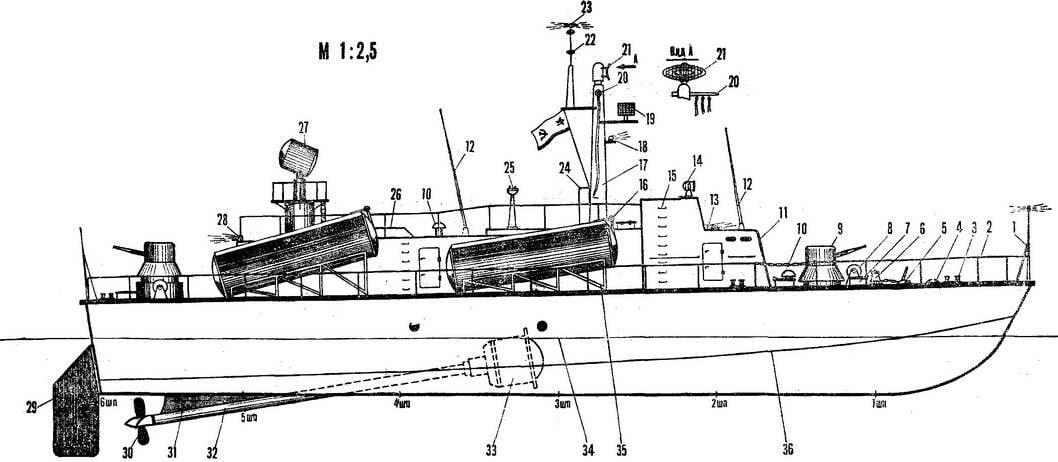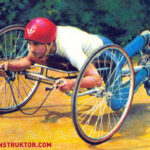 The model of modern missile boats (Fig. 1), developed by the Central marine club DOSAAF intended for competitions.
The model of modern missile boats (Fig. 1), developed by the Central marine club DOSAAF intended for competitions. The housing (Fig. 2) is made movable. In the drawing, the second color the frames in full size. By using carbon paper or tracing paper need to be translated plywood with a thickness of 3-4 mm, and then cut a fret saw. Aligning the edges with a file and sandpaper, treated with a little with a file or needle file the slots for the stringers.
They can be cut from pine or spruce plank, but it is better to take the ready rack ship or model airplane kit. The nasal boss of basswood, alder or poplar, at least of pine. Before assembling the set of body joints of stringers and frames three or four times to coat with nitrocream AK-20 or emelita.

Fig. 1. Model rocket launch:
1 flagpole, 2 — rail, 3 — cleats, 4 — bale strap, 5 chain stopper, 6 — spike, 7 — hatch, 8 — view, 9 — art-setting, 10 — vent fungus, 11 — combat tower, 12 — whip antenna, 13 — side lights, 14 — signal spotlight, 15 — clamps-ladder, 16 — missile containers, 17 — mast, 18 — masthead light (white), 19, 21, 22 — radar 20 — signal ray, 23 — kotikovye fire, 24 — a box for signal flags, 25 — repeater gyrocompass, 26 — air 27 — radar, 28 — hamborsky fire (white), 29 — wheel, 30 — thruster, 31 — a, 32 — a stern tube, 33 — electric motor (4.5 volts), 34 .— the waterline 35 — rack missile container, 36 — cheek, a 37 — anchor 38 — chain Clusaz.

Fig. 2. The technology of making a model.

The details of model boats (the positions correspond to Fig. 1).
The sequence of Assembly. On a level Board or bench strengthen young nails deck stringer. To establish, fluff nitrocream the joints, frames, and the nasal boss. Then fix the keel bar and the rest of the stringers. When the glue is fully dry, set is treated with a file and emery paper stretched over a wooden block. Boss trimmed with a planer, cleaned with a file and sandpaper. To facilitate it can be hollowed.
Ready set to miss three to four times nitrocream, diluted with acetone or solvent for nitropaints. You can now proceed to the ship’s hull. To do this, use mm plywood or thick cardboard, which is fastened with small nails with glue. After plating, it is necessary to give the glue to dry thoroughly and then sand the hull with sandpaper. After that, the nails will zaglubit or take out, and the remaining hole repaired wooden pins with glue. And again, apply a layer of liquid nitrokey. The joints and holes of the nails cover with a thick oil or nitroshpaklevok.
Now place in the case mikromotorchika with deadwood, as shown in the drawing, and finally paint the body, previously covering it with a soft brush several times with liquid nitroshpaklevok (it is diluted with acetone or solvent to the density of a medium). When working with oil paints the entire surface of the filler are not covered and the case is again treated with fine emery paper.
To separate the top Board from the bottom stick the waterline. It can be made of celluloid or of thick thread. Top case painted in a ball (gray) colour, bottom — in red or green. The deck is brown or gray. It makes the cutout for the battery.
Combat tower is made of plywood, wood or cardboard. This detail putty and paint as well as the body. Missile containers can be made from a dense drawing paper, and the shelves under them to bend wire. The mast is made of wood. Sensible things — views, anchors, cleats, stoppers, lifelines — available materials: acrylic, celluloid, brass wire, tin etc.
All add-ons are painted gray, as freeboard. Cleats, windlass, stoppers, dampers, anchors are black. The finished model should be tested and adjusted on the water. Her draught must be exactly at the waterline. If the model is small, it added lead. You should also check to trim (tilt) on the nose or stern and side roll. You can then run the model, achieving a stability of the steering.
Main dimensions
Length (L) mm: 560
Width (B) mm: 116
Board height (H) mm: 54
Draught (T) mm: 30
Displacement (D), g: 1150
V. TSELOVALNIKOV, the master of sports of international class



